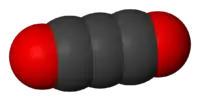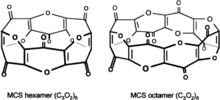 | |
 | |
| Names | |
|---|---|
| Preferred IUPAC name
Propa-1,2-diene-1,3-dione | |
| Identifiers | |
3D model (JSmol) |
|
| ChEBI | |
| ChemSpider | |
| MeSH | Carbon+suboxide |
PubChem CID |
|
| UNII | |
CompTox Dashboard (EPA) |
|
| |
| |
| Properties | |
| C3O2 | |
| Molar mass | 68.031 g·mol−1 |
| Appearance | colorless gas |
| Odor | strong, pungent odor |
| Density | 3.0 kg/m3, gas[1]
1.114 g/cm3, liquid[2] |
| Melting point | −111.3 °C (−168.3 °F; 161.8 K) |
| Boiling point | 6.8 °C (44.2 °F; 279.9 K) |
| reacts | |
| Solubility | soluble in 1,4-dioxane, ether, xylene, CS2, tetrahydrofuran |
Refractive index (nD) |
1.4538 (6 °C) |
| 0 D | |
| Structure | |
| rhombic | |
| quasilinear (phase dependent) | |
| Thermochemistry | |
Heat capacity (C) |
66.99 J/mol K |
Std molar entropy (S⦵298) |
276.1 J/mol K |
Std enthalpy of formation (ΔfH⦵298) |
−93.6 kJ/mol |
| Related compounds | |
Related oxides |
carbon dioxide carbon monoxide dicarbon monoxide |
Related compounds |
carbon subsulfide carbon subnitride |
Except where otherwise noted, data are given for materials in their standard state (at 25 °C [77 °F], 100 kPa).
Infobox references | |
Carbon suboxide, or tricarbon dioxide, is an organic, oxygen-containing chemical compound with formula C3O2 and structure O=C=C=C=O. Its four cumulative double bonds make it a cumulene. It is one of the stable members of the series of linear oxocarbons O=Cn=O, which also includes carbon dioxide (CO2) and pentacarbon dioxide (C5O2). Although if carefully purified it can exist at room temperature in the dark without decomposing, it will polymerize under certain conditions.
The substance was discovered in 1873 by Benjamin Brodie by subjecting carbon monoxide to an electric current. He claimed that the product was part of a series of "oxycarbons" with formulas Cx+1Ox, namely C2O, C3O2, C4O3, C5O4, …, and to have identified the last two;[3][4] however, only C3O2 is known. In 1891 Marcellin Berthelot observed that heating pure carbon monoxide at about 550 °C created small amounts of carbon dioxide but no trace of carbon, and assumed that a carbon-rich oxide was created instead, which he named "sub-oxide". He assumed it was the same product obtained by electric discharge and proposed the formula C2O.[5] Otto Diels later stated that the more organic names dicarbonylmethane and dioxallene were also correct.
It is commonly described as an oily liquid or gas at room temperature with an extremely noxious odor.[6]
Synthesis
It is synthesized by warming a dry mixture of phosphorus pentoxide (P4O10) and malonic acid or its esters.[7] Therefore, it can be also considered as the anhydride of malonic anhydride, i.e. the "second anhydride" of malonic acid.[8]
Several other ways for synthesis and reactions of carbon suboxide can be found in a review from 1930 by Reyerson.[6]
Polymerization
Carbon suboxide polymerizes spontaneously to a red, yellow, or black solid. The structure is postulated to be poly(α-pyronic), similar to the structure in 2-pyrone (α-pyrone).[9][10] The number of monomers in the polymers is variable (see Oxocarbon#Polymeric carbon oxides). In 1969, it was hypothesized that the color of the Martian surface was caused by this compound; this was disproved by the Viking Mars probes (the red color is instead due to iron oxide).[11]
Uses
Carbon suboxide is used in the preparation of malonates; and as an auxiliary to improve the dye affinity of furs.
Biological role

Carbon suboxide, C3O2, can be produced in small amounts in any biochemical process that normally produces carbon monoxide, CO, for example, during heme oxidation by heme oxygenase-1. It can also be formed from malonic acid. It has been shown that carbon suboxide in an organism can quickly polymerize into macrocyclic polycarbon structures with the common formula (C3O2)n (mostly (C3O2)6 and (C3O2)8), and that those macrocyclic compounds are potent inhibitors of Na+/K+-ATP-ase and Ca-dependent ATP-ase, and have digoxin-like physiological properties and natriuretic and antihypertensive actions. Those macrocyclic carbon suboxide polymer compounds are thought to be endogenous digoxin-like regulators of Na+/K+-ATP-ases and Ca-dependent ATP-ases, and endogenous natriuretics and antihypertensives.[12][13][14] Other than that, some authors think also that those macrocyclic compounds of carbon suboxide can possibly diminish free radical formation and oxidative stress and play a role in endogenous anticancer protective mechanisms, for example in the retina.[15]
Structure and bonding
The structure of carbon suboxide has been the subject of experiments and computations since the 1970s. The central issue is the question of whether the molecule is linear or bent (i.e., whether ). Studies generally agree that the molecule is highly non-rigid, with a very shallow barrier to bending. According to one study, the molecular geometry is described by a double-well potential with a minimum at θC2 ~ 160°, an inversion barrier of 20 cm−1 (0.057 kcal/mol), and a total energy change of 80 cm−1 (0.23 kcal/mol) for 140° ≤ θC2 ≤ 180°.[16] The small energetic barrier to bending is around the same order of magnitude as the vibrational zero-point energy. Therefore, the molecule is best described as quasilinear. While infrared[17] and electron diffraction[18] studies have indicated that C3O2 has a bent structure in the gas phase, the compound was found to possess at least an average linear geometry in the solid phase by X-ray crystallography, although the large thermal ellipsoids of the oxygen atoms and C2 have been interpreted to be consistent with rapid bending (minimum θC2 ~ 170°), even in the solid state.[10]
A heterocumulene resonance form of carbon suboxide based on minimization of formal charges does not readily explain the molecule's non-rigidity and deviation from linearity. To account for the quasilinear structure of carbon suboxide, Frenking has proposed that carbon suboxide be regarded as a "coordination complex" of carbon(0) bearing two carbonyl ligands and two lone pairs: .[19] However, the contribution of dative bonding in C3O2 and similar species has been criticized as chemically unreasonable by others.[20]

References
- ↑ "Carbon Suboxide". WebElements Periodic Table. Retrieved 19 Feb 2019.
- ↑ Weast RC, Astle MJ, eds. (1983). CRC Handbook of Chemistry and Physics (64th ed.). Boca Raton: CRC Press. p. B-82. ISBN 9780849304637.
- ↑ Brodie BC (1873). "Note on the Synthesis of Marsh-Gas and Formic Acid, and on the Electric Decomposition of Carbonic Oxide". Proc. R. Soc. Lond. 21 (139–147): 245–247. doi:10.1098/rspl.1872.0052. JSTOR 113037.
When pure and dry carbonic oxide [=carbon monoxide] is circulated through the induction-tube, and there submitted to the action of electricity, a decomposition of the gas occurs [...] Carbonic acid [=carbon dioxide] is formed, and simultaneously with its formation a solid deposit may be observed in the induction-tube. This deposit appears as a transparent film of a red-brown color, lining the walls of the tube. It is perfectly soluble in water, which is strongly colored by it. The solution has an intensely acid reaction. The solid deposit, in the dry condition before it has been in contact with the water, is an oxide of carbon.
- ↑ Brodie BC (1873). "Ueber eine Synthese von Sumpfgas und Ameisensäure und die electrische Zersetzung des Kohlenoxyds". Liebigs Ann. 169 (1–2): 270–271. doi:10.1002/jlac.18731690119.
- ↑ Berthelot M (1891). "Action de la chaleur sur l'oxyde de carbone". Annales de Chimie et de Physique. 6 (24): 126–132. Archived from the original on 17 February 2012. Retrieved 21 Feb 2007.
- 1 2 Reyerson LH, Kobe K (1930). "Carbon Suboxide". Chem. Rev. 7 (4): 479–492. doi:10.1021/cr60028a002.
- ↑ Diels O, Wolf B (1906). "Ueber das Kohlensuboxyd. I". Chem. Ber. 39: 689–697. doi:10.1002/cber.190603901103.
- ↑ Perks HM, Liebman JF (2000). "Paradigms and Paradoxes: Aspects of the Energetics of Carboxylic Acids and Their Anhydrides". Structural Chemistry. 11 (4): 265–269. doi:10.1023/A:1009270411806. S2CID 92816468.
- ↑ Ballauff M, Li L, Rosenfeldt S, et al. (2004). "Analysis of Poly(carbon suboxide) by Small-Angle X-ray Scattering". Angewandte Chemie International Edition. 43 (43): 5843–5846. doi:10.1002/anie.200460263. PMID 15523711.
- 1 2 Ellern A, Drews T, Seppelt K (2001). "The Structure of Carbon Suboxide, C3O2, in the Solid State". Z. Anorg. Allg. Chem. 627 (1): 73–76. doi:10.1002/1521-3749(200101)627:1<73::AID-ZAAC73>3.0.CO;2-A.
- ↑ Plummer WT, Carsont RK (1969). "Mars: Is the Surface Colored by Carbon Suboxide?". Science. 166 (3909): 1141–1142. Bibcode:1969Sci...166.1141P. doi:10.1126/science.166.3909.1141. PMID 17775571. S2CID 31568906.
- ↑ Kerek F (2000). "The structure of the digitalislike and natriuretic factors identified as macrocyclic derivatives of the inorganic carbon suboxide". Hypertension Research. 23 (Suppl S33): S33–38. doi:10.1291/hypres.23.Supplement_S33. PMID 11016817.
- ↑ Stimac R, Kerek F, Apell HJ (2003). "Macrocyclic carbon suboxide oligomers as potent inhibitors of the Na,K-ATPase". Ann. N. Y. Acad. Sci. 986 (1): 327–329. Bibcode:2003NYASA.986..327S. doi:10.1111/j.1749-6632.2003.tb07204.x. PMID 12763840.
- ↑ Kerek F, Stimac R, Apell HJ, et al. (2002). "Characterization of the macrocyclic carbon suboxide factors as potent Na,K-ATPase and SR Ca-ATPase inhibitors". Biochimica et Biophysica Acta (BBA) - Biomembranes. 1567 (1–2): 213–220. doi:10.1016/S0005-2736(02)00609-0. PMID 12488055.
- ↑ Tubaro E (1966). "Carbon suboxide, the probable precursor of an antitumor cellular substance: retina". Bollettino Chimico Farmaceutico (in Italian). 105 (6): 415–416. PMID 6005012.
- ↑ Brown RD (1993). "Structural Information on Large Amplitude Motions". In Laane J, Dakkouri M, Veken Bv, et al. (eds.). Structures and Conformations of Non-Rigid Molecules. NATO ASI Series. Vol. 410. Springer Netherlands. pp. 99–112. doi:10.1007/978-94-011-2074-6_5. ISBN 9789401049207.
- ↑ Jensen P, Johns JW (1986). "The infrared spectrum of carbon suboxide in the ν6 fundamental region: Experimental observation and semirigid bender analysis". J. Mol. Spectrosc. 118 (1): 248–266. Bibcode:1986JMoSp.118..248J. doi:10.1016/0022-2852(86)90239-0.
- ↑ Clark A (1970). "The potential function for the CCC bending in carbon suboxide". Chem. Phys. Lett. 6 (5): 452–456. Bibcode:1970CPL.....6..452C. doi:10.1016/0009-2614(70)85190-9.
- ↑ Frenking G, Tonner R (2009). "Divalent carbon(0) compounds". Pure Appl. Chem. 81 (4): 597–614. doi:10.1351/pac-con-08-11-03. ISSN 1365-3075. S2CID 98257123.
- ↑ Himmel D, Krossing I, Schnepf A (2014). "Dative Bonds in Main-Group Compounds: A Case for Fewer Arrows!". Angewandte Chemie International Edition. 53 (2): 370–374. doi:10.1002/anie.201300461. ISSN 1521-3773. PMID 24243854.
External links
- WebElements page on compound's properties
- "Katalog der Deutschen Nationalbibliothek" [Catalog of the German National Library]. German National Library | dnb.de (in German).